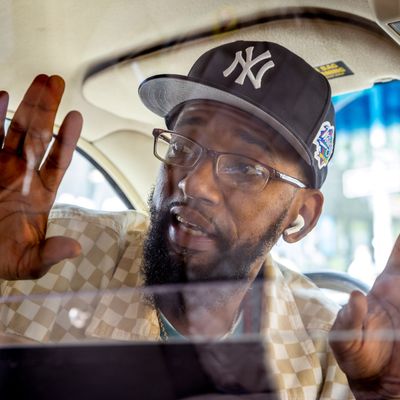
“Don’t call it a tour,” Modesto “Flako” Jimenez says as we pull up to the curb. We’re in a maroon pirate cab: Jimenez is driving while narrating, and I’m in the back, busily noting down observations — at his direction. Taxilandia certainly seems like a tour, in that it mainly consists of a drive around Bushwick, during which Jimenez explains the history of certain squares, parks, furniture stores, even food carts. Still, Jimenez insists there’s a distinction between what Taxilandia is doing and what other trend-chasing tour guides are up to. “Vogue told them ‘Bushwick is hot,’” he says, his voice dripping disdain. On a video panel embedded in the cab’s front seat, he shows me a video of one such gaggle, secretly filmed from the back. We’re looking at the same mural, on the same street as the group in the video, but he urges me to see the difference. He pauses long enough that the moment shifts — there’s not that much daylight between this experience and that — and unease sets in. We roll on.
The simultaneous layering of those feelings — comfort and discomfort — is part of the show’s complex and delicate choreography. Boundaries slide and shift and melt. In some form, Jimenez has been working on Taxilandia for more than ten years. He was working on it when he drove a cab in Bushwick; he was letting it sift through his mind as he worked with the downtown experimental juggernauts the Wooster Group. One of his earlier bilingual pieces, ¡Oye! For My Dear Brooklyn, contained some of the same ideas he uses here, which makes me suspect that, like a neighborhood, Jimenez’s tender tribute to Bushwick will never solidify into some finished state. I can’t even tell you how long Taxilandia is because I’m not sure when it ended. There was a long dénouement standing on the sidewalk under a Biggie mural, when Jimenez’s sermonizing and the life on the street flowed into our own conversation. Was that the show?
Taxilandia’s key metaphor surfaces at a wall covered in graffiti. We drive up and park for a while, so we can examine it in detail. Jimenez has clearly spent hours looking at this wall, fascinated by its ever-changing profusion of nearly unreadable names, the way one artist writes over another tag, leaving the earlier tag still visible. A gorgeous fat-lettered yellow cursive currently dominates the wall, but beneath it you can see an elaborate gray shape, with horns or ears like a cat, and further down, you see the hint of something brown. He finds significance in this overwriting, how graffiti writers superimpose but do not erase. As he drives around the neighborhood, he too is passing between strata — past and present, poetry and explanation, tour and not-tour.
His subject is gentrification, and certainly the only way to tell such a story is in onionskin layers. He casts backward to Brooklyn’s early history to talk about the area’s German inhabitants and their breweries, pointing to the places where their pride shows through, like a tiny square with a monument to a German American soldier from World War I. He shows us where the neighborhood has since marked its own racial divisions, where it burned in the 1970s, where community has held tight in the face of civic disinvestment and development greed.
For Flako, everything is a monument. He’s used to finding salvation in odd places, not just at the wall of murals that boasts a bright array of heroes or the pay-by-the-hour motel (at some points his guide-patter dissolves into a melancholy poem about a lost love) but also at the shoe store, where he managed to talk his mother into letting him get Nikes. Those shoes saved him from being bullied as a schoolboy who wore Payless sneakers, and in his caffeinated energy you can still sense the bob-and-weave that Jimenez learned from those brutal grade-school lessons. History and how long Jimenez has been part of this neighborhood is the subtext of almost every part of Taxilandia, expressed both in his deep knowledge of the place’s archaeology and his easy banter with people we pass. He calls out to a guy waiting in front of a bodega; he joyfully hassles a friend, whose own car has passed us at a light.
Jimenez has thought carefully about the hustle (“We all have one, right?”), so parts of Taxilandia are actually … ads. He’s often talking up the other components of his project, like the self-guided walk Textilandia, the mural he’s commissioned, or the television installations he’s collaborated on with local businesses which feature Brooklyn poets. (He can be scathing about mural projects he finds exploitative, effusive about the ones painted by local collectives.) He is also scrupulous about spending money locally as we go, whether in a bodega or at a street cart near his apartment. Paying attention and paying cash are similar but not the same, he says, and Jimenez leads by example — if you put your dollar down, you keep the grocery in the neighborhood a little longer.
In front of one of the corner stores, Jimenez sees someone he recognizes, someone he thinks might be selling drugs, as he once did. “He’s hustling drugs, I’m hustling clarity,” he says. Well, not exactly. “Clarity” implies clear outlines, a clean distinction between categories. Taxilandia, with its hyperwealth of detail, anecdote, and poetry, does something quite different. It illuminates by jumbling; it reveals by piling up. It shows all the neighborhood’s lives superimposed at once, painted one on top of another. And in this way, Jimenez offers a way to see the city’s constant churn with subtler vision. Add your name to the wall, yes — but leave enough room and transparency to see the ones that were there first.
Tickets to Taxilandia are available at nytw.org through May 30.


